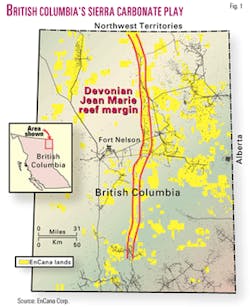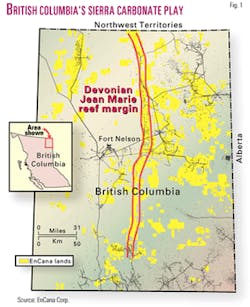EnCana pursues Northeast BC Devonian reef margin play
One of Canada's largest oil and gas companies is pursuing unconventional gas opportunities in Northeast British Columbia in what it calls the largest regional gas play discovered in western Canada in the last decade.
The leader in the play, EnCana Corp., Calgary, said it has booked 600 bcf of reserves in the Upper Devonian Jean Marie reef margin play since entering Sierra in 1998 and ultimately expects to recover more than 2.5 tcf on company lands.
With completion of a large land acquisition program in early June 2002, EnCana held more than 2 million net acres in the Greater Sierra play.
The field is a "world class discovery which will be a key element in our long term gas growth strategy," said Randy Eresman, president of EnCana's Onshore North American Division.
"The region's resource potential on EnCana lands is estimated at more than 5 tcf of sweet gas in place, and we expect to recover more than half of that."
Steady progress
EnCana has been steadily acquiring mineral rights and extending the productive limits of the play.
"Each year our technical and operations teams have improved their understanding off the play, moving from the lower productivity carbonate platform to the more prolific reef margin," Eresman said.
During the 2001-02 drilling season, EnCana drilled 45 wells and added about 150 bcf of established reserves. About half the wells targeted the reef margin.
Eresman said EnCana expects Greater Sierra gas production, now about 150 MMcfd from 200 wells, to more than double in the next 3 years and continue to grow after that.
So far 500 potential drilling locations have been identified, and current plans are to drill about 100 wells/year.
EnCana is well positioned as to infrastructure. It owns seven gas processing plants with about 200 MMcfd of capacity in the area.
It also has long-term transportation commitments with Duke Energy Gas Transmission in British Columbia and TransCanada PipeLines Ltd.'s Alberta system.
Geologic features
The Jean Marie carbonate is present throughout much of Northeast British Columbia.
EnCana said the most prolific wells are located east of Fort Nelson, BC. The reef margin is 3-5 miles wide and more than 175 miles long from the Northwest Territories to the Rocky Mountains Disturbed Belt.
Typical wells in the reef margin will produce 2-4 MMcfd the first year and then stabilize around 1 MMcfd with a reserve life of more than 10 years. Gas in place is estimated at 5-10 bcf/sq mile in the undersaturated reservoir.
En Cana said Greater Sierra would be uneconomic without two technologies: horizontal drilling and underbalanced circulation. Both are applied innovatively, the company said.
Wells are drilled about 1,400 m vertically, then horizontally about 1,000 m through the Jean Marie. The underbalanced drilling involves using inert nitrogen foam instead of a water-based drilling fluid. The use of conventional water-based muds in this type of formation would create a water phase trap that would severely reduce gas productivity.
EnCana has targeted operating costs at less than 50¢/Mcf, and its success rate along the margin has been about 90% so far.

